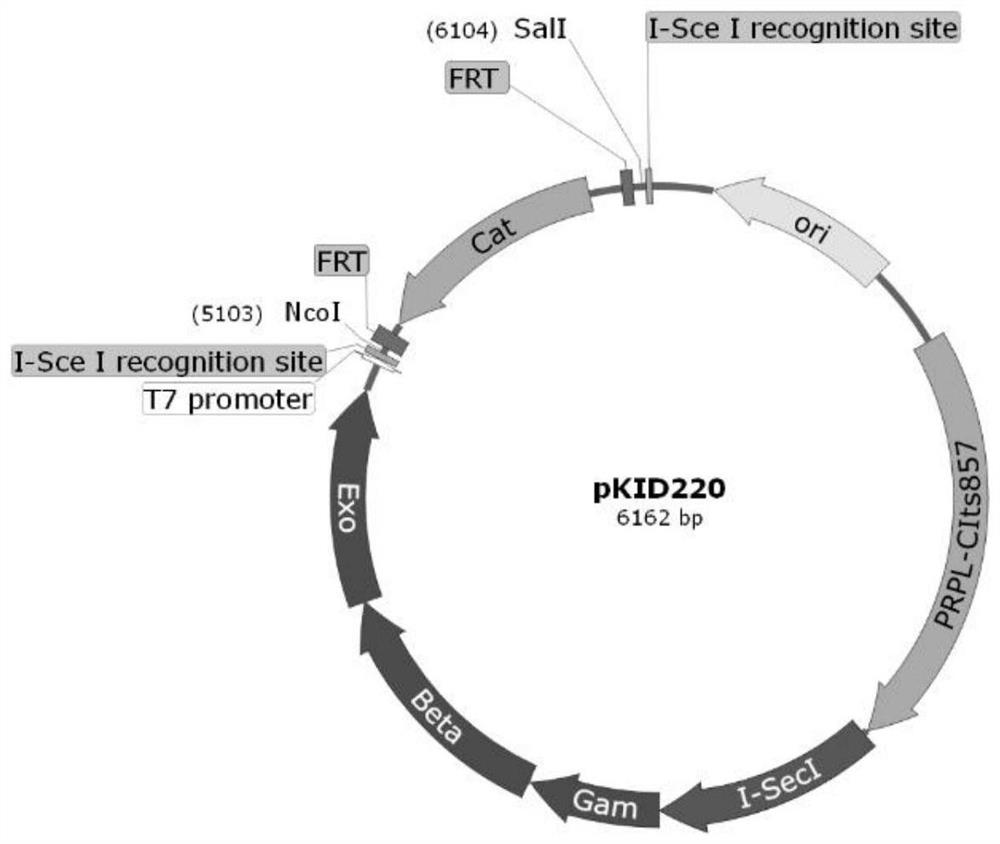Temperature-controlled self-cleaving single plasmid homologous recombination system and application thereof in gene editing
A technology of homologous recombination and gene editing, applied in the field of genetic engineering, to avoid accidental rearrangement, save time and cost, and be easy to operate
- Summary
- Abstract
- Description
- Claims
- Application Information
AI Technical Summary
Problems solved by technology
Method used
Image
Examples
Embodiment 1
[0044] Example 1: pKID220 plasmid construction
[0045] pKID220 plasmid with temperature control element Cits857-P R P L , to control the sequential expression of I-SceI endonuclease and Red recombinase, the construction process is as follows figure 1 shown. Specific steps are as follows:
[0046] 1. With the pDC plasmid (nucleotide sequence shown in SEQ ID NO.2) as the backbone, the chloramphenicol resistance gene cassette carried by it is flanked by I-SceI endonuclease recognition sites and FLP enzyme recognition targets (FRT). Using the pBV220 plasmid as a template, the 1483bp temperature control element CIts857-P was amplified with pDCprpL-F and pDCprpL-R primers R P L Fragment (sequence shown in SEQ ID NO.3), and the PCR product was cloned into pDC plasmid through Nhe I site to obtain pDC-CItsPRPL plasmid.
[0047] 2. Use primer pair ISceI-F / R and primer pair GBe2-F / R to amplify respectively from pKISa plasmid (nucleotide sequence as shown in SEQ ID NO.5) with codi...
Embodiment 2
[0055] Example 2: Knockout of the pgtE gene of Salmonella enteritidis
[0056] The pKID-UD knockout plasmid is constructed by inserting the flanking DNA sequence carrying the pgtE gene into the targeting fragment region of the pKID220 plasmid, and is used to knock out the pgtE gene from Salmonella enteritidis. Operation process such as image 3 shown.
[0057] The specific operation steps are as follows:
[0058] 1. Use HFF1 and HFR1 primers (shown in Table 1) to amplify the upstream homology arm PgtE of 871bp from the Salmonella enteritidis SM6 strain genome up (sequence shown in SEQ ID NO.6), then use HRF1 and HRR1 primers to amplify the downstream homology arm PgtE of 963bp from SM6 genome down (The sequence is shown in SEQ ID NO.7).
[0059] 2. The pKID220 plasmid was double digested with NcoI and SalI to obtain the chloramphenicol resistance gene fragment FCF (1041bp) with FRT sites on both sides and the backbone fragment CIGBE of 5121bp. Transformation of PgtE by ov...
Embodiment 3
[0063] Embodiment 3: INP0862 gene replaces Salmonella enteritidis pgtE gene
[0064] The pKID-INP0862 knock-in (replacement) plasmid is constructed by inserting the flanking DNA sequence carrying the INP0862 gene into the targeting fragment region of the pKID220 plasmid, and is used to replace the pgtE gene of Salmonella enteritidis with the INP0862 gene. Operation process such as Figure 5 shown. The specific operation steps are as follows:
[0065] 1. Using the pET28a-INP0862 plasmid as a template, use HF0862-F and HF0862-R primers (shown in Table 1) to amplify by PCR to obtain a 1480bp INP0862 gene fragment (sequence shown in SEQ ID NO.8). The One Step Cloning Kit was used to clone into pKID-UD through the Nco I site, and the ligated product was transformed into SM6 strain by electroporation. Specifically, 10 μL of the ligation product was added to the pre-prepared competent cells, and then electroporation was completed by a Bio-Rad micropulse generator (parameters were ...
PUM
 Login to View More
Login to View More Abstract
Description
Claims
Application Information
 Login to View More
Login to View More - R&D
- Intellectual Property
- Life Sciences
- Materials
- Tech Scout
- Unparalleled Data Quality
- Higher Quality Content
- 60% Fewer Hallucinations
Browse by: Latest US Patents, China's latest patents, Technical Efficacy Thesaurus, Application Domain, Technology Topic, Popular Technical Reports.
© 2025 PatSnap. All rights reserved.Legal|Privacy policy|Modern Slavery Act Transparency Statement|Sitemap|About US| Contact US: help@patsnap.com



